|
Remarkable Rookies - I
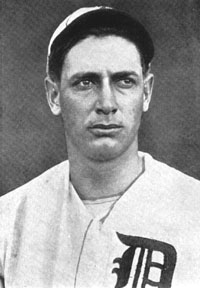
Ed Summers
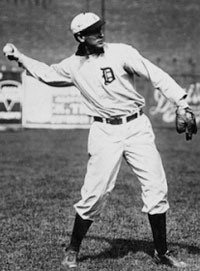
Ed Summers
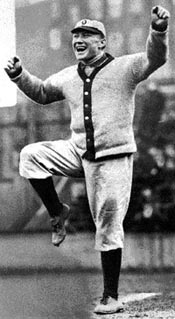
Hughie Jennings

Ed Killian
|
Ed Summers - 1908
Oron Edgar Summers was nicknamed "Kickapoo" because of his Indian ancestry.
- Born in Indianapolis, the right-hander pitched for nearby Wabash College in 1903 before joining a class B team the next season.
- The 6'2" 180-pounder moved up the ladder before hitting a ceiling at class A in 1906. But he rejuvenated his career in '07 when he developed a knuckleball, which was dubbed a "dry spitball" at that time since its unpredictable trajectory imitated the spitball, which was legal until 1920.
- Summers could deliver the pitch sidearm or underhanded as well as overhand. He didn't use it to the exclusion of other pitches. Ed explained, The reason I didn't resort to it oftener was because it proved an awful wear and tear on my fingers. But I am getting accustomed to it now.
- After leading the Indianapolis rotation in 1907, Summers attracted the attention of both the Cleveland and Detroit clubs. The Tigers won the battle, purchasing Summers, who was scheduled to report after the American Association season ended in mid-September. However, he decided not to go to Detroit, which won the AL pennant but lost the World Series to the Chicago Cubs.
Summers reported to spring training with the Tigers for the '08 campaign.
- He made the club and took the mound April 16 for his ML debut in Chicago. He held the White Sox to four hits to win 4-2 in ten innings.
- The rookie led the Tigers with 24 victories, six more than the next best hurler, Bill Donovan. His 1.64 ERA also topped the staff.
- Included in his victories were both games of a doubleheader September 25 in Detroit against the Philadelphia Athletics. That started the Tigers on a tengame winning streak, during which Summers won two more games. That set up the deciding three-game series with the White Sox to end the season. Although Summers lost the second game, the Tigers won the final day to take the AL pennant by a half game over Cleveland and 1.5 over Chicago.
- Manager Huey Jennings planned to start Summers in the third game of the World Series but had to bring him in to replace Ed Killian in Game One during the Cubs' 4-run 3rd. Ed held the Chicagoans to a single run through the 8th as the Tigers came back to take a 6-5 lead. But Summers couldn't close the victory. The rain that had fallen during the first three innings returned and played havoc with Ed's knuckleball. The Cubs pounded six hits for five runs to win 10-6.
- With Chicago holding a 2-1 lead in games, Summers started Game 4 and pitched well, surrendering only 3 runs on 10 hits. But Mordecai Brown shut out the Tigers. The Cubs won again the next day for their second straight Fall Classic triumph over Detroit.
Summers had another successful season in 1909, although not as good as his rookie campaign.
- After hurling 301 innings in '08, Summers threw 282 the next season but still finished with a respectable 19-9 record and 2.24 ERA.
- The Tigers made the World Series for the third straight season. But the third time wasn't a charm as they lost again, this time to Pittsburgh in seven games.
- With the series tied 1-1, Jennings decided at the last minute to start Summers over George Mullin despite threatening skies. The result was that Summers became the first P in the brief history of the World Series not to survive the first inning. All but one of the eight batters he faced reached base to put the Tigers in a 5-0 hole from which they couldn't recover. Rumors surfaced after the series that Summers had been suffering from dysentery prior to the game.
- After Ed pleaded with his manager for another shot, Jennings gave him the ball for Game 5 in Pittsburgh. But the second chance didn't turn out well. Summers walked in a run in the first, let in another in the second on a wild pitch, and surrendered a third tally in the next inning. Once again, the Tigers rallied and tied the game at 3 in the 6th. But in the 7th, the Pirates got two singles before a three-run HR by player-manager Fred Clarke. Acting "like a petulant, overgrown kid," Summers fired the next pitch into Honus Wagner's ribs. The great SS then stole second and third, continuing home on the catcher's wild throw into LF.
Summers' win production continue to decline and his ERA increased each of his next three seasons with the Tigers.
- 1910 saw him win only 13 games against 12 losses with a 2.53 ERA. Detroit's string of post-season appearances ended.
- Ed started the 1911 season out of action because of an assortment of ailments, including rheumatism. He finally made his debut May 30 when he beat Cleveland 3-2 in ten innings. He finished at .500 (11-11) with a 3.66 ERA in 179 innings.
- In 1912, Summers experienced arm problems that delayed his first start until Memorial Day again. After two unimpressive outings, Detroit put him on the waiver wire. When no one claimed him, they brought him back. He started June 21 but didn't survive the first inning as his ERA ballooned to 4.86. After a few more weeks on the bench with arm miseries, he was released to Providence.
- Instead of returning to the minors, Kickapoo decided to retire and went home to Indiana. His only direct contact with the game came in 1916 when he coached the Wabash College team.
Reference: "Ed Summers," Phil Williams, SABR Baseball Biography Project
|
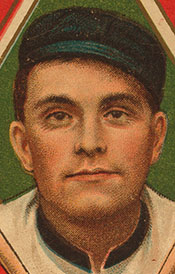
Russell Ford
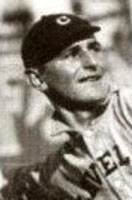
Bugs Resigl
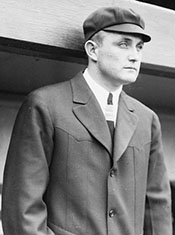
Billy Evans

Cy Falkenberg
|
Russell Ford was in his third year of minor league ball in 1907, playing for the Atlanta Crackers of the Class A Southern Association.
- Primarily a spitball pitcher, the Canadian-born hurler had a good year in 1906 at age 23 with the Class B Cedar Rapids (IA) Rabbits, winning 22 and losing only 9.
- That got him his promotion to Atlanta, where he went 15-10 in '07 and 16-14 in '08.
- The New York Highlanders (who would become the Yankees) drafted him before the 1909 season.
- Ford made his ML debut April 28, 1909, on a cold day in Boston. The results were ugly. He pitched one inning in a hopelessly lost game and recorded this line: 4 hits, 4 walks, 4 runs (3 earned). That gave him a 9.0 ERA, which he didn't have a chance to improve since the Highlanders sent him to Jersey City.
The demotion caused Ford to return to a pitch he had discovered by accident during his 1908 season with Atlanta.
After posting a 13-13 record with a 2.41 run average (researchers being unable to determine how many runs were unearned from the box scores of the day) and allowing only 172 hits in 276 innings, Ford got another chance with the Highlanders.
- He won 26 games and lost only 6 in 1910 with an ERA of 1.65 (which wasn't as sparkling in that Deadball Era as it would be today). The 26 victories set an American League rookie record that has yet to be broken. Russ called his special pitch a "slide ball," which he claimed was a variation of his spitball.
- As was also typical on those years, Ford finished 29 of the 33 games he started, twirling eight shutouts.
- His success helped the Highlanders finish in second place (88-63), their best performance in four years.
- Ford attributed his success to his ability to throw 14 different versions of his "spitball." Umpire Billy Evans recalled, Ford worked cleverly. He had the emery paper attached to a piece of string, which was fastened to the inside of his undershirt. He had a hole in the center of his glove. At the end of each inning, he would slip the emery paper under the tight-fitting undershirt, while at the start of each inning, he would allow it to drop into the palm of his glove.
Ford was no one-year wonder.
- He won 22 in 1911, losing 11 with a 2.27 ERA.
- But Russ was not as effective the following season, surrendering the most earned runs in the league (115) and most HRs (11). His ERA increased to 3.55.
- He pitched one more season for New York, compiling a 12-18 record and a 2.66 ERA.
- Two events caused Ford to switch to the new Federal League for the 1914 season. First, the American League banned the emery ball. And the Highlanders wanted to cut his pay. So Russ switched to the new Federal League.
The secret to Ford's success was exposed when a second P resurrected his career using the pitch. Cy Falkenberg had toiled in the majors for eight years, winning no more than 14 games in any season. Consigned to AA Toledo in 1912, Cy used his new pitch to compile a 25-8 record. That brought him back to Cleveland. Since he was not a spitballer, Falkenberg's new drop raised suspicions when the 33-year-old hurler had by far the best season of his career: 23-10. Imitation being the sincerest form of flattery, there were rumors that the entire Red Sox staff and several Yankee moundsmen were using the pitch.
- Pitching for Buffalo in 1914, Ford won 21 games and losing 6. He had a 3:1 strikeout-to-walk ratio.
- The Federal League joined the American and National circuits in banning the emery ball for the '15 season. That condemned Ford to a lackluster 5-9 mark for the Blues in 1915.
- The Federal League folded after its second season, and Russ never pitched in a major league game again.
Reference: "Russ Ford," T. Kent Morgan and David Jones, SABR Baseball Biography Project
Tales from the Deadball Era, Mark S. Halfon (2014)
|
Grover Cleveland Alexander - 1911
In 1911, Grover Cleveland Alexander had the greatest rookie season of any P in history. However, it began with an incident that some might have thought a bad omen.
- He hurled his first game for the Philadelphia Phillies in their home park Baker Bowl in the annual City Series with the A's, the defending World Champions. C Pat Moran told Alex, "You'll pitch five innings. They'll be murder, but you'll learn something." Well, what he learned was that he could succeed in the bigs. The 24-year-old rookie allowed no runs and no hits and walked none in five innings.
- Alexander was scheduled to make his regular season debut against the New York Giants on April 14. However, a fire that destroyed the grandstand of the Polo Grounds the night before postponed the game. (The Giants shared the Yankees' Hilltop Park until the Polo Grounds was rebuilt.)
- Instead, "Pete" made his first start in Boston, losing to the Braves 5-4 in 10 innings.
- Alexander won 28 games to establish the modern rookie mark that has yet to be touched.
- One of his victories came in 12 innings against the Braves. Opposing him was 44-year-old Cy Young, who was hurling his final ML game. After 11 scoreless frames, the Phils touched Cy for the game's only run to deny him his 512th victory.
- Alexander compiled an even better season in 1915: 31-10 with a 1.22 ERA. Despite pitching in the coziest ballpark in the league, "Pete" twirled 12 shutouts. He also defeated the Red Sox 3-1 in the opening game of the World Series.
|
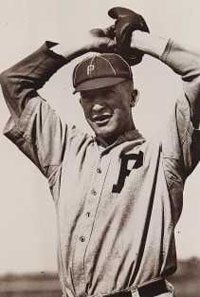
Grover Cleveland Alexander
|
|
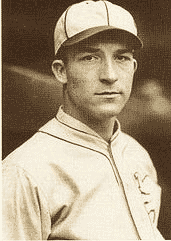 Al Simmons
Al Simmons

Al Simmons on the cover of
Sports Illustrated
|
Hall of Famer Aloysius Harry Simmons enjoyed one of the finest rookie seasons any hitter ever had.
- 22-year-old Al Simmons joined Connie Mack's Philadephia Athletics in 1924.
- Installed in LF, he played 152 games and put up these statistics.
BA .308, RBI 102, HR 8, 2B 31, 3B 9, SLG .431, OBP .343
(Of course, On-Base Percentage is a stat computed retroactively.)
- Al finished eleventh in the AL MVP balloting.
The .308 average would be by far his lowest through the 1934 season.
- No sophomore jinx affected Simmons. In 1925, he jumped to 2nd in the MVP voting on the basis of these numbers.
BA .387, RBI 129, HR 24, 2B 43, 3B 12, SLG .599, OBP 1.018
He led the AL in AB (654), H (253), and TB (392).
- Al became famous for his "foot in the bucket" style of hitting. Despite stepping toward 3B as the pitch came, he used his long arms and long bat to reach outside pitches. He could drive the ball with power to all fields.
- He starred on the Philadelphia team that won the AL pennant in 1929, 1930, and 1931. That team "may have been the greatest baseball club ever assembled," as the Sports Illustrated cover pictured at the left proclaims.
- He tore up AL pitching through 1934, when, at age 32, he hit .344 for the Chicago White Sox. He slumped in 1935 to .267 and only 79 RBI.
- But he bounced back in '36 to hit .327 and drive in 112 for the Detroit Tigers.
- After two good, not great, years with Washington in 1937-8, Al spent a year in the National League with the Boston Bees and Cincinnati.
Obsessed with reaching 3,000 hits, Simmons continued playing long after he was effective.
- Mack took Al back on the A's in 1940-1 as a player-coach, but he got only 28 more hits.
- After not playing in 1942, Simmons played in 40 games for the Red Sox in 1943 and four more for the A's in 1944.
- Finally, at age 42, he gave up with 2,297 hits.
- Looking back on his career, Al rued the times he had begged off playing to nurse a hangover or left a one-sided game early for a quick shower and a night's pleasures.
- As a result, Simmons imparted this advice to another player of Polish heritage. "Never relax on any time at bat; never miss a game you can play." The young recipient was Stan Musial, who took Al's advice to heart and rapped out 3,630 hits.
|
|
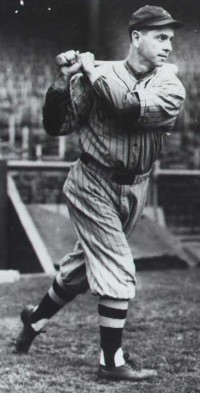
Earl Averill
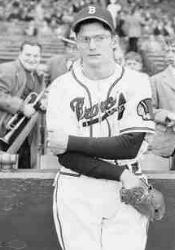
Earl Torgeson
|
You've probably never heard of Snohomish WA. It is a town of only 8,640 souls NE of Seattle. Yet it has produced two ML players, one of whom is in the Hall of Fame.
- Earl Averill was the first AL player to hit a HR in his first ML at-bat (and also the only Hall-of-Famer to do so). He connected on April 16, 1929, for Cleveland off Earl Whitehill of Detroit.
- He had a sensational rookie year:
.332, 110 R, 198 H, 18 HR, 96 RBI
- The "Earl of Snohomish" played 10 productive seasons in the OF for the Tribe, hitting over .300 in eight of them, including a high of .378 in 1936 (which didn't even lead the league as Luke Appling hit .388).
- He knocked home 143 runs in 1931 and belted over 30 HRs three times. He finished his career with a .318 average, 238 HRs, and 1,162 RBIs.
Earl is famous as the batter who lined a ball off Dizzy Dean's foot in the 1937 All-Star game, starting a chain of events that ruined Dizzy's arm.
- Ironically, Averill was himself ailing at the time of the 1937 All-Star Game. A week earlier, his legs had become momentarily paralyzed as he left the clubhouse for a pre-game workout.
- Hospital X-rays revealed that he had a congenital spine malformation. As a result, he altered his hitting style and become more of a spray hitter.
- With his power diminished and his average slipping, "Rock" was just an average player for the remaining four years of his career.
- Traded to Detroit in 1939, he played in his only World Series for the Tigers the following season.
- Averill's son Earl (born in Cleveland, not Snohomish) followed him into the major leagues (1956-63).
The other Snohomish product is Earl Torgeson, named for Averill.
- Torgeson had a serviceable ML career at 1B from 1947-1961 with the Braves, Phillies, Tigers, White Sox, and Yankees.
- Earl was one of the few players who wore glasses on the field.
Personal note: Earl Torgeson has always occupied a soft spot in my heart. First of all, he is responsible for my acquiring a baseball within five minutes of first entering a ML park.
- It was the summer of 1954 at Sportsman Park, home of a 13-year old boy's beloved Cardinals. As the usher led us to our seats in the lower grandstand down the RF line, Torgeson was taking batting practice for the Phillies. As we walked up the aisle, he pulled a liner into the stands. It skipped across the empty seats, hit my mother lightly on the hip, and lodged in the folded up chair a step ahead of me. As my older brother blocked out a guy running over from the left, I picked up the horsehide before even reaching my seat!
- Coincidentally, I had been using an Earl Torgeson 1B mitt in the summer league at City Park.
|
|
18-year-old SS Pete Reiser signed with the Cardinals of his native St. Louis in 1937. However, on April 1, 1938, Commissioner Kennesaw Mountain Landis, who despised Branch Rickey's farm system, granted Reiser and eight other minor leaguers free agency.
- The only player in the released group that Rickey wanted to keep was Pete. So Branch called his pal Larry MacPhail, GM of the Brooklyn Dodgers. The two came to a gentlemen's agreement that Larry would sign Pete and hide him in the low minors for several years before trading him back to St. Louis.
- As a result, Pete signed for $100 with the Dodgers, who sent him to Class D.
After a year at Newport (AK) and New Iberia (LA), Reiser made a spectacular debut with Brooklyn in spring training in 1939.
- In his first 11 trips to the plate against major league pitching, he hit four HR and four singles and drew three walks. Manager Leo Durocher raved to the press about the phenom from Class D, predicting that he would be his opening day SS.
- All this attracted the attention of Rickey, who sent MacPhail a telegram reminding him of their agreement. Larry then sent Durocher instructions to stop playing Pete and send him to the minor league camp for further instruction.
- Durocher, who was as much a conniver as the two GMs, confronted MacPhail and even punched him when Larry held his ground. The GM fired his manager on the spot but forgave him the very next day.
- Nevertheless, Durocher could see that MacPhail was adamant and optioned Reiser to Class A Elmira (NY). Converted to a switch-hitter, Pete he played in 38 games and hit .301 in the OF before bone chips in his right elbow sidelined him.
- When Reiser began the 1940 campaign hitting .378 at Elmira, he was advanced to AAA Montreal and then to the parent club. In 58 games with the Dodgers at 3B, SS, and the OF, Pete batted .293.
- Now that the young phenom had attracted attention across the league, any hope of trading him back to St. Louis without arousing the ire of Landis faded.
That set the stage for his first full year as a big-leaguer.
- Installed in the OF for good, Reiser had a sensational 1941 season. The bold numbers indicate figures that led the NL.
BA .343, RBI 76, HR 14, 2B 39, 3B 17, SLG .558, OBP .406, TB 299
- Pete made the All-Star team and finished second in the NL MVP voting to teammate Dolph Camilli.
- The Dodgers won the NL pennant by 2.5 games over St. Louis. One wonders if the outcome would have been reversed had Reiser stayed with the Cards.
Pete didn't fare well in his first World Series, which the Dodgers lost to the Yankees in five.
- Playing every inning of each game, Reiser hit .200 (4-for-20). He had a single, a double, a triple, and a homer.
- He led all batters in the Series with 6 Ks.
- Pete's best game was the "Mickey Owen Game," the fourth. He went 2-for-5 with a single and a 2-run HR over the scoreboard in RCF. The Dodgers led 4-1 with two outs in the ninth when C Owen missed the third strike to allow Tommy Henrich to reach first. The Yankees then rallied for four runs to take a commanding 3-1 lead in the Series.
For the 1942 season, Brooklyn had a new GM. With MacPhail inducted into the service, none other than Branch Rickey took his place, no doubt overjoyed that the promised trade for Reiser never happened.
- Pete continued to tear up the league, hitting .380 in mid-July. Leading the second-place Cardinals by 8 games, the Dodgers went to St. Louis for a fateful four-game series.
- On Sunday, July 19, in the second game of a DH, Enos Slaughter came to the plate in the bottom of the 11th with the score tied 6-6. "Country" belted a Whitlow Wyatt delivery deep to CF. Reiser raced toward the fence and snagged the drive in full stride a second before smashing into the concrete wall. The ball fell from his glove and, although stunned, he threw to the cutoff man. However, Slaughter easily scored the winning run to complete the sweep as the crowd of 34,443 threw cushions on the field for 10 minutes despite the pleas of the PA announcer to stop.
- In the meantime, Pete lay on his back on the OF grass. One account says that blood trickled out of his ears. X-rays showed a "slight concussion but no fracture." (At least one source claims he also separated his shoulder.) After several days in the hospital and against the recommendation of the doctor, Reiser tried to resume playing but was a shadow of his former self. He would suffer from headaches and dizziness the rest of his career.
- The Cardinals won 45 of their last 51 games to snatch the pennant by two games. Dodger fans have always insisted that Reiser's injury cost their beloved Bums a second straight pennant.
After serving three years in the military, Pete returned to Brooklyn for the '46 season.
- He led the league with 34 SB but hit only .277 – not bad but 100 points lower than what he had hit before his concussion.
- Reiser continued playing until 1952 but hit over .300 only once, in 1947 (.307).
- Durocher, who later managed the young Willie Mays with the New York Giants, said: "Pete had everything Willie Mays did. Except luck."
|
 Pete Reiser
Pete Reiser
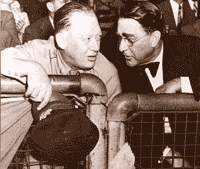
Larry MacPhail and Branch Rickey

Leo Durocher
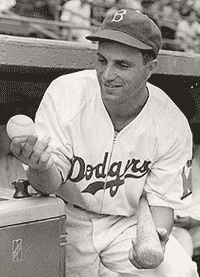
Dolph Camilli
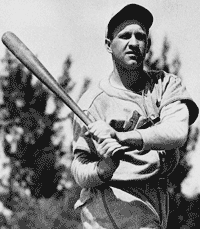
Enos "Country" Slaughter
|
|
RHP Johnny Beazley was one of the 91 farmhands of the St. Louis Cardinals who were made free agents by Commissioner Kennesaw Mountain Landis in 1938. Landis opposed the farm system set up by St. Louis GM Branch Rickey because it kept good players in the minors because there was no room on the parent club for them.
20-year old Beazley signed with the New Orleans Pelicans for his fourth pro season. The Southern Association team was a Cardinals farm club. As a reward for his 16-win 1941 season with the Pelicans, the Cardinals called up Beazley during the final week of the season. On the last day of the season, with the Brooklyn Dodgers having clinched the pennant, Manager Billy Southworth gave Johnny a start. The greenhorn scattered 10 hits in a complete game 3-1 victory over the Chicago Cubs.
Beazley earned a spot in the Cardinals' starting rotation the following spring. He responded with an outstanding season as St. Louis turned the tables on the Dodgers to win the 1942 NL crown by two games.
- Johnny won 21 and lost only 6. Only teammate Mort Cooper's 22 victories topped the rookie's total.
- His ERA was a sparkling 2.13. He completed 13 of his 23 starts.
- Johnny fanned 91 and walked 73.
Johnny topped his sensational season with two victories over the Yankees in the World Series.
- After St. Louis lost the opener 7-4 at Sportsman's Park, Southworth sent Beazley out to even the series. With his mother looking on, he came through with flying colors with his mother in attendance. Leading 3-0 in the top of the eighth, the rookie surrendered a three-run HR to Charlie Keller. But in the bottom of the inning, rookie LF Stan Musial singled home RF Enos Slaughter to take a 4-3 lead. Today, the closer would pitch the ninth. But in 1942, Beazley returned to the mound. C Bill Dickey led off with an IF hit and was replaced by PR Tuck Stainback. 1B Buddy Hassett singled to RF, but Slaughter retrieved the ball and threw a strike to third to cut down Stainback. In another move you would never see today, Manager Joe McCarthy sent P Red Ruffing up to PH. Ruffing drilled a liner to RF but Slaughter chased it down. Finally, Beazley got SS Phil Rizzuto on a slow roller. The fans tossed thousands of seat cushions onto the field to celebrate the victory.
- When the Series moved to Yankee Stadium, the Cards won Game 3 2-0 and Game 4 9-6. Beazley toed the slab for Game 5. The game was tied 2-2 heading into the ninth. With a runner on base, 3B Whitey Kurowski smashed a line drive into the LF seats. Johnny then closed out the Yanks aided by C Walker Cooper's pick off of Joe Gordon at 2B. The Cards swamped Beazley in jubilation.
Beazley received a hero's welcome in his native Nashville TN. He gave his $6,100 World Series check to his mother.
The Army had waited for his season to end but would wait no longer. He ended up in the Pacific in what amounted to a morale unit. He pitched games at various bases until he hurt his arm.
When Johnny returned to the Cards in 1946, he was a shadow of his former self.
- He compiled a 7-5 record but pitched only one scoreless inning in the World Series against the Red Sox.
- The Cardinals traded Beazley to the Boston Braves before the '47 season. In the next three years, he pitched only nine, three, then one game.
- He pitched in the minors through 1951 before retiring.
Beazley used his St. Louis ties to obtain a Falstaff beer distributorship in Nashville. He died in 1990 at age 71.
|
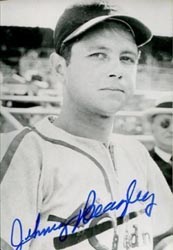
Johnny Beazley

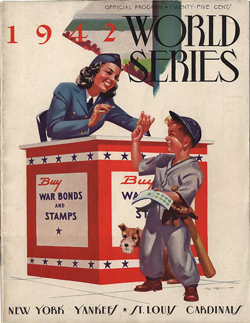

Kurowski, Slaughter, and Beazley celebrate '42 Series win.
|
|

Boo Ferriss
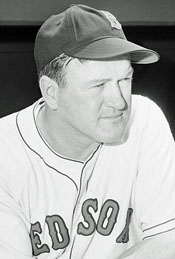
Joe Cronin
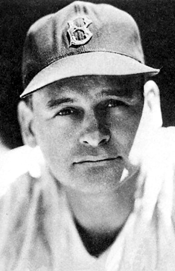
Bob Johnson
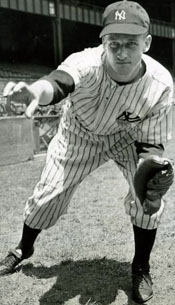
Hank Borowy
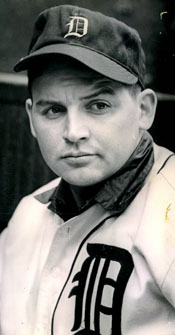
Stubby Overmire
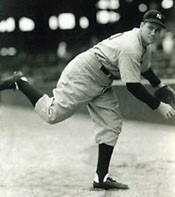
Tiny Bonham
|
Boo Ferriss - 1945
Dave "Boo" Ferris was born in Shaw MS in 1921.
- His nickname came from his inability to pronounce "brother" at an early age.
- He received a full baseball scholarship to Mississippi State, where he pitched in 1941 and 1942.
- Less than a year after signing with the Red Sox in '42, he was inducted into the Army Air Force but was discharged a little over two years later because of asthma. (Interestingly, that disease has not prevented him from living to the age of 94 as this is written.)
- He was told by doctors not to play baseball because of his condition. But he didn't consider that an option. I had a ball in my hands as long as I can remember, and I like baseball. All I ever wanted to be was a ball player. I never wanted to be a fireman or engineer, just a ball player.
- When the Red Sox lost their first eight games of the '45 season, Boo was called up and pressed into action.
To say that his big league debut was sensational is an understatement.
- He made his debut in the first game of a doubleheader April 29 at Shibe Park. Throwing mostly a sidearm curveball, Boo twirled a five-hit shutout against the Philadelphia Athletics.
- That started an incredible streak of pitching that included the most consecutive scoreless innings - 22 - at the beginning of a career.
- Dave's winning streak finally ended Sunday, June 10 before 41,216 at Yankee Stadium.
- Hank Borowy outdueled him 3-2.
- June 15 at Griffith Stadium, Boo had to work extra hard to get back into the winning column. In his toughest outing, he gave up four in the 5th to the Senators but the Red Sox tied the game with five in the 7th. The 6'2" righthander shut down the home team until the Sox finally plated a run in the 14th to prevail 6-5.
- Not getting any extra rest, he returned to the hill June 21 (on yours truly's fourth birthday) and lost to the Yankees again, this time at Fenway. New York pounded him for ten runs (only eight earned) in 4 1/3 innings. He gave up only seven hits but uncharacteristically walked six.
- He took the mound again June 24, facing the Nats again, this time in Fenway. Amazingly, the final score was the same as his previous outing against them, 6-5, but in the regulation nine innings.
- Boo won again the next Friday, his third victory over the White Sox, 4-2.
- His winning streak reached four with victories over the Browns 7-4 July 1 and Tigers 4-3 just three days later as part of an Independence Day doubleheader.
- He tossed his fourth shutout on the last day before the All-Star break. The Indians fell in Municipal Stadium 6-0.
- Boston reached the All-Star break in 5th place at 37-35, just a half-game behind Chicago.
For the only time since it was inaugurated in 1933, the All-Star game scheduled for Fenway Park was cancelled at the last minute (July 10).
(The Red Sox hosted the game the following season.) Seven out of eight interleague night games were played July 9 and 10 to help support the American Red Cross and the National War Fund. The Red Sox defeated the Braves 8-1 before a crowd of 22,809 at Fenway Park. Boo started and threw three shutout innings.
After going 14-2 before the break, Ferriss faded some the second half, in part because the hot humid weather exacerbated his asthma.
- Friday the 13th was lucky for Boo as he went 4-0 against the White Sox, 6-2.
- He kept his record spotless against the Browns, 3-2 in St. Louis.
- He then suffered his first two-game losing streak.
- Ferriss held a 1-0 lead over the Senators until the visitors struck for three in the 8th to win 3-1.
- The Yankees beat him 4-2 in ten innings July 31.
- The Senators cured his losing blues August 4 when the Red Sox romped 15-4 in the nation's capital.
- August 8 produced his fifth loss as Stubby Overmire prevailed 5-2 in Detroit.
- Win #19 came on the road at the expense of the Indians 7-1 August 12.
- It took Dave three times to get the magic 20th victory.
- His win-loss alternation continued as the White Sox finally got to him to the tune of 12 hits and six runs in four innings.
- Dave again failed to win his 20th in St. Louis, the Browns touching him for 15 hits and eight runs although the Red Sox won 10-8 in 13 innings.
- In the 7th and last game of a weeklong series in St. Louis (as part of wartime scheduling to cut down on travel), Boo got what today would be called a save by getting the last two outs in a 5-4 victory.
- Back home in Boston two days later, Dave finally got his 20th 4-3 over Philadelphia.
- The Mississipian lost his next two starts, both on the road as August turned into September, 7-1 to the Yanks and 11-5 to the Senators.
- A week's rest helped Boo when he toed the slab again September 10. The result was a 9-2 romp over the Tigers to give him a 21-8 record.
- That turned out to be his last victory of the season.
- The White Sox collected 12 hits and 6 runs in six innings to give him a 6-1 loss September 16.
- A week later, he lost a tough 2-1 decision to Tiny Bonham in the second game of a doubleheader that was called after five innings because of darkness.
Between games of the doubleheader, the Red Sox staged Ferriss Day before a paid crowd of 28,743 that turned out for the final home games of the season. A committee presented him a Lincoln Zephyr that was originally custom built for Mrs. Edsal Ford. The Red Sox gave their rookie of the year a radio along with a gold wrist watch and a gold key chain. The Rotarians of Mississippi supplied a big bunch of posies.
- Cronin chose not to use his star rookie in the final two games in New York as his Red Sox sank to 7th.
Boo Ferriss final record for 1945: 21-10, 2.96 ERA, 31 GS, 26 CG, 5 SHO, 94 K, 85 BB.
Ferriss had another outstanding season in 1946 when all the stars returned from the military.
- Boo gained 25 victories against only 6 defeats to lead the AL in winning % (.806).
- The Red Sox won their first pennant since 1918 and lost to the Cardinals in a thrilling seven-game World Series.
- Boo shut out St. Louis in Game 3 at Fenway Park, a six-hitter.
- He started Game 7 but was taken out after 4 1/3, yielding 7 hits and 3 runs.
- Boston was favored to repeat in 1947, but starters Ferriss, Tex Hughson, and Mickey Harris all developed sore arms.
- None ever fully recovered. Boo went 12-11 in '47 and 7-3 in '48 but had no decisions in only five games the next two years before calling it quits at age 28.
Reference: "Dave Ferriss," David Pietrusza, SABR Baseball Biography Project (2000)
Teenager on First, Geezer at Bat, 4-F on Deck: Major League Baseball in 1945, James D. Szalontai (2009)
|

Alex Rodriguez
|
After 17 games with Seattle in 1994 and 48 more in 1995, 20-year-old Alex Rodriguez played SS for 146 games for the Mariners in 1996. Because he had played too many games the previous two seasons combined, he was not eligible for the Rookie of the Year award. Good thing for the other contenders because these are the numbers he put up in his first full season in the AL.
.358, 36 HR, 123 RBI, 141 R, .631 Slug.%
- The .358 BA led the league over Frank Thomas's .349.
- The 141 R nosed out Chuck Knoblauch of Minnesota by one for tops in the AL.
- A-Rod also led in Total Bases (379) and Doubles (54).
- His 215 hits ranked second to Paul Molitor's 225 for the Twins.
- A-Rod also committed only 15 errors at SS.
- Alex finished second to Juan Gonzalez of the Texas Rangers for the MVP Award.
- Another sensational SS won the AL Rookie of the Year Award – Derek Jeter.
.358 remains by far his highest BA in his career. Of course, the 36 HR were puny compared to the numbers he cranked out in subsequent years, including 52 in 2001 and 57 in 2002 (the tainted years with the Rangers) and 54 in 2007. He was the MVP in 2003, 2005, and 2007. Does this trend mean he's due again in 2009? [He'll get a late start with his injury rehab and probably won't be MVP.]
|
|
|
CONTENTS
Ed Summers - 1908
Russell Ford - 1910
Grover Cleveland Alexander - 1911
Al Simmons - 1924
Earl Averill - 1929
Pete Reiser - 1941
John Beazley - 1942
Boo Ferriss - 1945
A-Rod - 1996
Baseball
Magazine
Top
of Page |




























